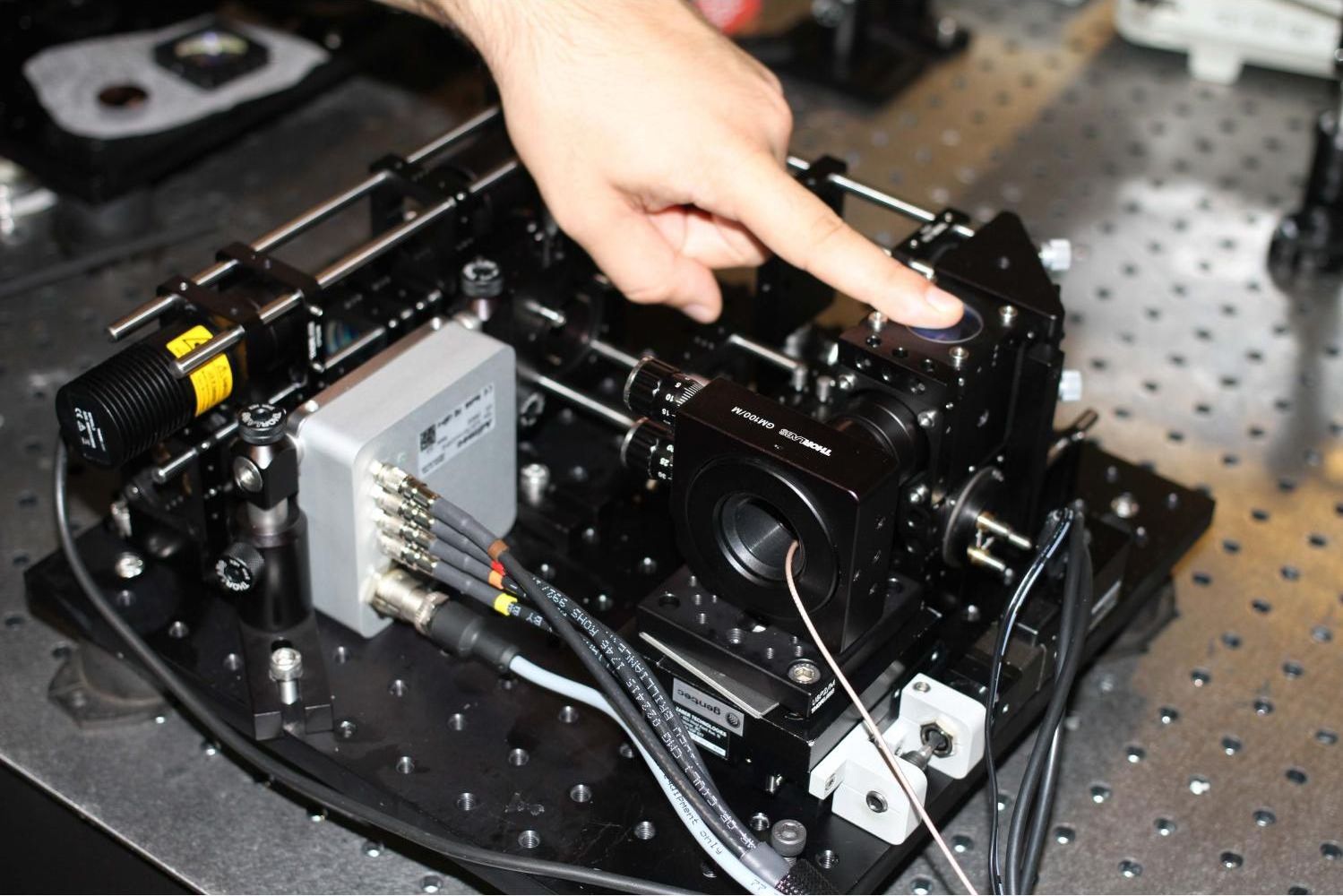Light-based fingerprint sensing
Capture d'empreintes digitales basé sur la lumière
Many live-scan fingerprint sensors were using optical means in the past, taking advantage of the frustrated reflection on a glass interface. This is still the main technique for governmental applications where it is important to acquire a large image, and many clever variations exist.
- FTIR: frustrated total internal reflection / contact
- Reflection with sweep
- Reflection with direct sensor contact
- Transmission through the skin
- Reflection Touchless
- Optical Coherence Tomography
But regular optical sensors are too large and expensive when addressing the smartphone market: electrical/capacitive sensors are more adapted. But we may see a comeback of optical sensor in the close future, when they will be integrated with the (optical) display.
FTIR: frustrated total internal reflection
Reflection with contact
Réflexion avec contact
The oldest 'live-scan' readers use frustrated refraction over a glass prism (when the skin touches the glass, the light is not reflected but absorbed). The finger is illuminated from one side with a LED while the other side transmits the image through a lens to a camera. (FTIR: frustrated total internal reflection).
La plus ancienne technique de capture d'empreinte "live" est l'usage de
la réflexion totale sur un prisme en verre (lorsque la peau touche le verre,
la lumière n'est plus réfléchie, elle est absorbée). Le doigt est éclairé à l'aide
d'une DEL (diode électroluminescente) par un coté du prisme, tandis que
l'image est récupérée de l'autre coté avec une lentille et un capteur d'image.
(Ce schéma date de 1996, les capteurs CMOS étaient fort rares...)
- (2000) Here is the example of the Compaq fingerprint reader (CMOS camera).
Governmental applications
Two main types exist for governmental applications :
- FAP20: one fingerprint
- FAP60: 4 fingers (slap fingers)
IAFIS FAQ for more details.
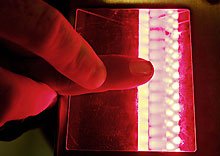
Variant
Many companies are offering such FTIR devices, this is a common technology. Some are offering some variants less common.
Cette technologie de capture est très courante, et de nombreuses compagnies l'utilisent. Quelques-unes offrent des variantes moins courantes.
- Nagoya University uses a micro-collimator instead of the fiber optic, enabling direct fingerprint comparison.
L'université de Nagoya utilise un micro-collimateur à la place de la fibre optique, afin de réaliser une comparaison directe de l'empreinte.
(1999) Fingerprint Sensor with Micro Collimator (Nagoya Univ.)
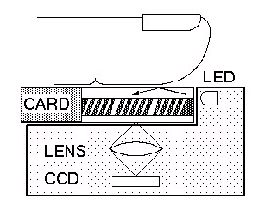
Direct image / Image directe
It's also possible to simply take a picture of the finger touching a glass, or something else.
- (2015) Vkansee introduces a 2000dpi reader, UTFIS, using advanced pinhole imaging techniques to take a high-resolution image.
- (2018 Jun) The Vivo NEX flagship smartphone has an in-display fingerprint sensor. It has been a big surprise for me to see that it's a regular camera with a very short focus lens or a pinhole.
- (2009) GelSight, Inc. provides extremely detailed and rapid surface measurements through the GelSight sensor technology. [2009 SIGGRAPH Emerging Technologies]
- This is not a sensor specifically for fingerprint. But a very original method, close to the touchless reading in fact.
- Microgeometry Capture using an Elastomeric Sensor
- Retrographic sensing for the measurement of surface texture and shape
Reflection with sweep
Réflexion avec balayage
Sweep is a variant of the regular FTIR acquisition: the finger must swipe over the sensor to get a full image. This enables to make smaller, thinner acquisition devices.
Kinetic Sciences
- (1999) Kinetic Sciences
and Cecrop/Sannaedle have proposed sweep optical sensors.
Kinetic Sciences et Cecrop/Sannaedle ont proposé des capteurs optiques à balayage.
Paper describing the sensor (dead link):
http://www.smta.org/files/telecom_solutions02_immega.pdf
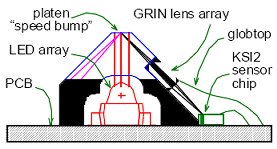
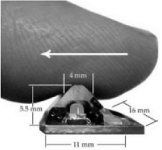
Casio
- Casio
+ Alps Electric uses a roller with the sensor inside. The roller acts like the prism.
Casio + Alps Electric utilise une roulette contenant le capteur. La roulette agit comme prisme.
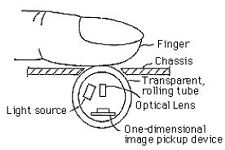
Digital Persona
- As well as Digital Persona with the Firefly
Ainsi que Digital Persona et son Firefly
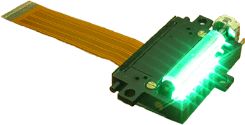
Reflection with direct sensor contact (lensless)
To avoid any lens to focus the image, and make a flat sensor, a direct contact of the skin with the sensor is proposed: it is important the skin to be close to the sensor, in general a photodiode, less than the pixel pitch (about 50 microns). The light is coming from below the skin (see further transmission through the skin).
TFT
TFT on glass substrate is a less expensive technology compared to silicon, and is flat : this was the first proposal.
(1997) Philips replaces the CMOS sensor by a TFT display, used as sensor. Philips has also worked with Ethentica to combine their technologies, but without known product. LG has also studied a TFT sensor.
Some other companies proposing TFT fingerprint sensors:
- (2004) Casio
- (2006) Silicon Image Works
- (2005) Silicon Display Technology
- (2004) Alps Electric
- (2003) Mitsubishi
- (2006) Seiko/Epson
- (2008) AU Optronics
- (2012) Integrated Biometrics' Sherlock
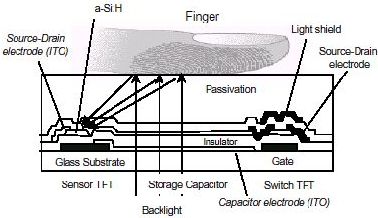
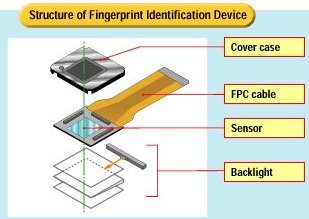
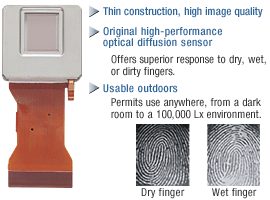
Polymer organic photodetector
- (2005 Jul) NanoIdent unveils a flexible fingerprint sensor using a polymer organic photodetector.
Transmission through the skin
Transmission à travers la peau
Red light is able to cross the skin, and so, it is possible to get an image of the lighted skin.
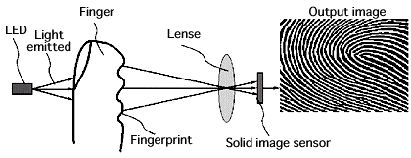
Mitsubishi
- Mitsubishi proposes to read the fingerprint with a regular camera.
Mitsubishi propose de lire l'empreinte avec une caméra normale. - (2005 Sep) Mitsubishi launches the Mitsubishi Finger Transmission Authentication Device
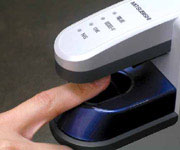
NEC, Delsy, Holtek
- NEC and
Delsy (and Secom?)
use a CMOS camera which is the size of the finger,
with a fiber optic in-between, the light is coming from the edges in this case.
NEC et Delsy (et Secom?) utilisent un capteur optique CMOS qui est nécessairement de la taille du doigt, avec une fibre optique déposée sur le capteur, la lumière provenant des bords dans ce cas. - (2015 Dec) Holtek is using this principle with the GH8111
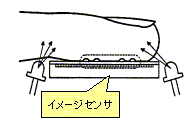
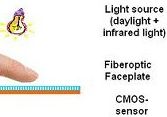
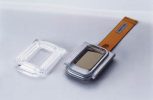
Mitsumi, NEC, Elecvision
- Mitsumi, NEC, Elecvision propose a variant, a sweep sensor.
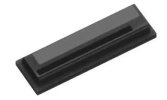
Reflection touchless (contactless)
Réflexion sans contact
Instead of touching a platen, the idea is to acquire directly the fingerprint image with an adapted camera. This is avoiding the distorsion linked to the finger pushed against the glass platen. But this is not that easy because of the low contrast between ridges and valleys -much less than FTIR. To compensate, structured light has been proposed.
- (1999) The first contactless reader seems to be the Compu-Scan 3000 from DDSI Digital Descriptor Systems, Inc..
- Thales (formerly Thomson-CSF) also proposed a contactless reader, but with the use of a special powder to put on the finger.
- (2011) The Biometric Systems Laboratory / Department of Computer Science /Università degli Studi di Milano is working on Touchless 3D fingerprint recognition.
- (2014) Contactless Fingerprint Technologies Assessment (Version 2) Phillip Wiggin & Dr. Lars Ericson.
- (Book) (2018) Contactless 3D Fingerprint Identification / Ajay Kumar
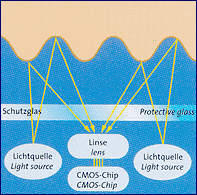
TST
- (2003) TST Touchless Sensor Technology removed the prism by directly reading the fingerprint, so the finger does not touch anything (but still need a guide to get the right optical distance).
- (2011) 3D capturing of fingerprints – on the way to a contactless certified sensor / D.Koller et al.
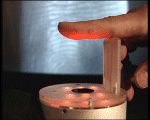
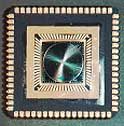
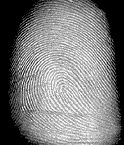
BERC
- (2004) The BERC lab from Yonsei University (Korea) also developped a touchless sensor.
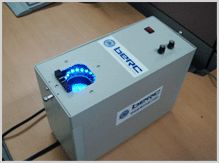
TBS
- (2005) TBS launches a touchless sensor with the "Surround Imaging".
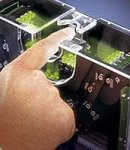
AOS
- (2011 Jan) AOS Advanced Optical Systems develops AIRprint, a device that detects fingerprints by shining polarized light onto a person's hand and analyzing the reflection using two cameras configured to detect different polarizations, able to scan fingerprints from up to two meters away.
- (2013) OnePrint & IDAir
- (2015) AOS Advanced Optical Systems installs at Schiphol its zero contact fingerprint sensor (ANDI OTG).
Lustrous Electro-Optics
- (2014 Sep) Compact touchless fingerprint reader based on digital variable-focus liquid lens C.W. Tsai ; P.J. Wang ; J.A. Yeh .
- C. W. Gary Tsai founded Lustrous Electro-Optics Inc. Hsinchu, Taiwan. See Digital liquid lens for fast scanning technologies
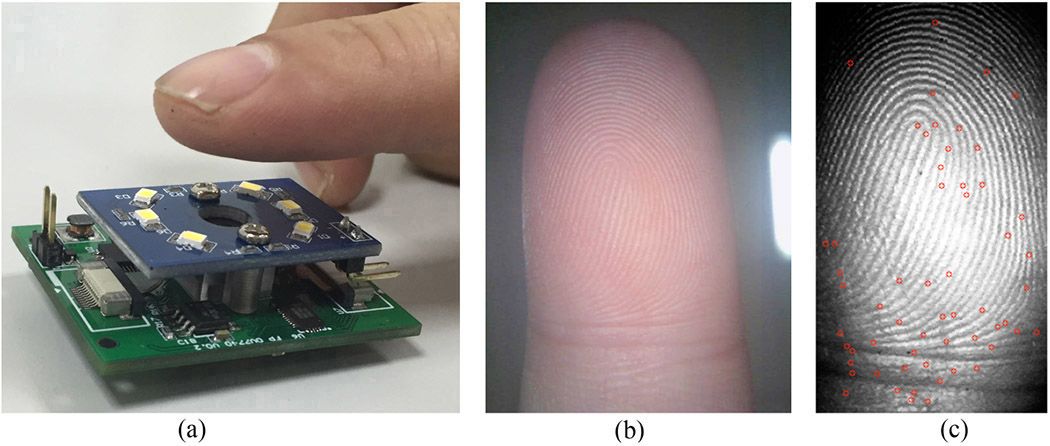
RICE university
- (2017 Apr) Rice graduate student Yicheng Wu demonstrates the SAVI prototype, which is able to capture fine details of an object from a distance, effectively replacing a large telephoto lens. The prototype camera is on a motorized track in the foreground at left, while a laser at right creates a speckle pattern on the target, a fingerprint.
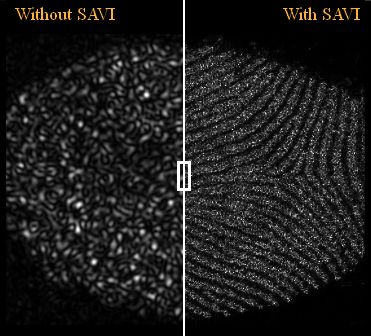
AIT Austrian Institute of Technology
- (2016) AIT Autrian Instritute of Technology proposes Biometric Contactless Fingerprint Technologies: ten-print contactless sensors.
Structured light / fringes
Lumière structurée
FlashScan3D + TBS
- (2009 Sep) FlashScan3D and TBS Holding unveils a new touchless fingerprint sensor technology using Structured Light Illumination (SLI) developped by two universities (University of Kentucky and Carnegie Mellon).
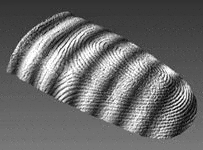
Idemia
- (2014 Aug) Finger On the Fly® from Safran/Morpho, now Idemia, is using structured light.
Papers
- (2014 Jan) 3D fingerprint imaging system based on full-field fringe projection profilometry/ Shujun Huang et al.
- (2018) Anti-spoof touchless 3D fingerprint recognition system using single shot fringe projection and biospeckle analysis/ Amit Chatterjee et al.
- (2018) Fringe Projection Profilometry based Secured Fingerprint Sensor/ Puneet Singh, Chatterjee et al.
OCT Optical Coherence Tomography
OCT enables to see the structures inside the skin, using interferomety. The interface between the derma and the epiderma shows the same fingerprint structure.
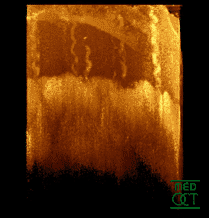
Papers
- (2007) Fingerprint detection using full-field swept-source optical coherence tomography / Dubey & al.
- (2011) Automation of Fingerprint Recognition Using OCT Fingerprint Images
- (2011) Fingerprint Spoof Detection By NIR Optical Analysis / Shang & al.
- (2013) Real-time in vivo computed optical interferometric tomography / Ahmad & al.
- (2013) Feasibility of correlation mapping optical coherence tomography (cmOCT) for anti-spoof sub-surface fingerprinting / Zam & al.
- (2015) Development of novel high-speed en face optical coherence tomography system using KTN optical beam deflector / Ohmi & al.
- (2015) Efficient internal and surface fingerprint extraction and blending using optical coherence tomography / Darlow & al.
- (2015) Elucidation of the Kinetochore structure using quantitative confocal laser scanning microscopy based technique / Kamweru
- (2015) Fingerprint imaging from the inside of a finger with full-field optical coherence tomography Egidijus Auksorius and A. Claude Boccara.
- (2017) Secure fingerprint identification based on structural and microangiographic optical coherence tomography / Liu & al.
- (2017) Novelty Detection-Based Internal Fingerprint Segmentation in Optical Coherence Tomography Images / Khutlang & al.
National Instruments
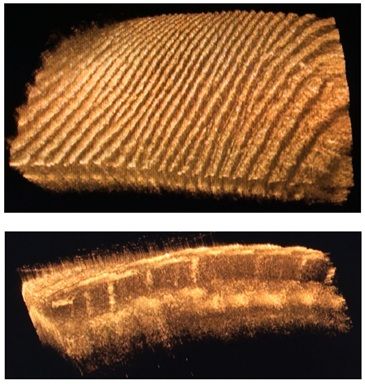
Illinois University
- (2013) Real-time in vivo computed optical interferometric tomography / Ahmad & al.
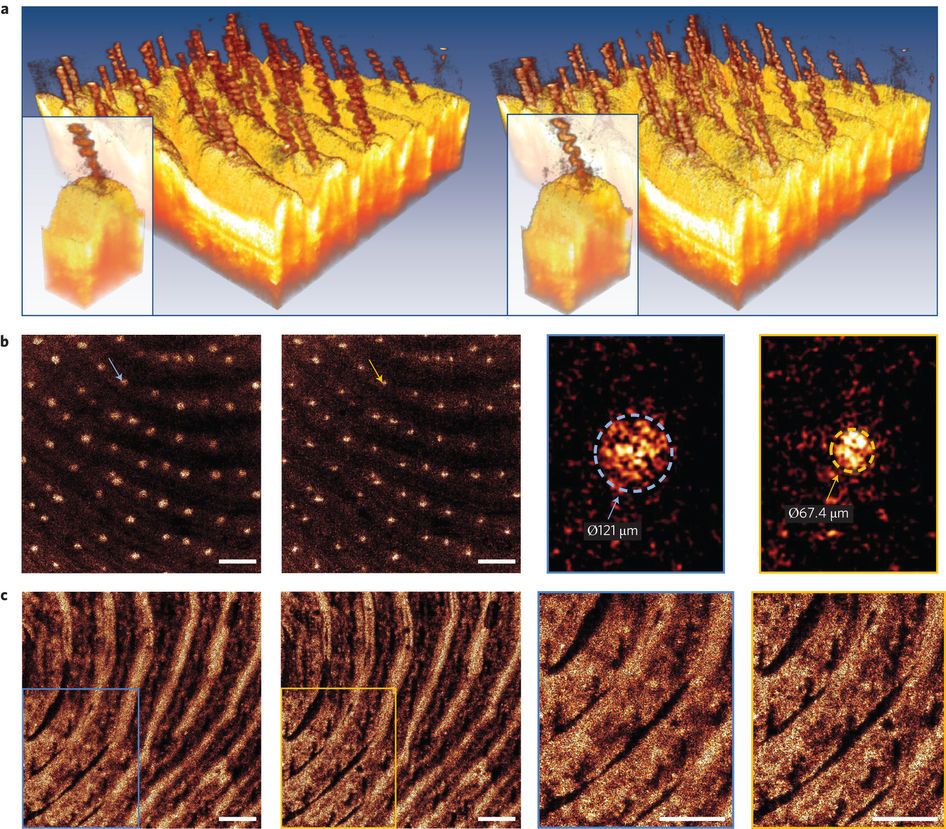
b, Representative en face planes (OCT left and ISAM right) with enlarged representative regions indicated by colour-coded arrows (blue, OCT; yellow, ISAM) showing the cross-section of the sweat ducts. The diameter of the sweat ducts obtained with ISAM more closely matches the known anatomical range of diameters.
c, En face planes (OCT left and ISAM right) at a (optical) depth of 780 µm below the surface, showing enhanced resolution deeper inside the superficial dermis. Scale bars, 500 µm.
Langevin Institute
- (2015 Oct) The Langevin Institute has made an OCT (optical coherence tomography) device specifically to acquire fingerprints.
